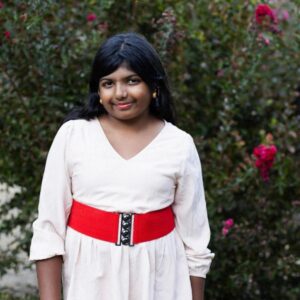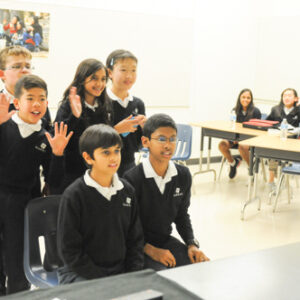This article originally appeared in the winter 2014 Harker Quarterly.
In spring 2012, Harker began offering online classes to students through the Global Online Academy, a consortium of schools that delivers online courses to students in 53 GOA member schools around the world. More than 20 Harker students are now enrolled in GOA courses covering a wide variety of topics, ranging from human rights to game theory to global health issues.
“It filled a little bit of a niche of trying something new and giving kids an opportunity to take some classes that we don’t offer,” said Evan Barth, academic dean at the upper school. “It’s offering a different medium for students who want to try [online learning] out.”
“I took a class through GOA because I wanted to take another math class, but there were no others in the main Harker catalog,” said Suzy Lou, grade 12. “So I looked on GOA and saw that there was an advanced statistics class and signed up for it.”
The global component of the classes also gives students a chance to interact with and learn the perspectives of students from cultures around the globe.
“When you have students from so many different places reflecting on where they’re from, you create a global community,” said Michael Nachbar, CEO of Global Online Academy, who shared his insights on a recent visit to Harker. “And that happens not just with kids from Jakarta and Jordan and the U.S. It also happens with kids from Atlanta and LA and Boston, that you start to see these varied perspectives being brought into the different topics that they’re learning about.”
GOA teachers are trained to keep global perspectives in mind when conducting their courses. “So when they’re framing discussion prompts or projects, they’re thinking about, where in this topic can students insert that local perspective?” said Nachbar.
Maya Valluru, grade 10, found this perspective to be one of the most interesting aspects of the journalism class she is taking through GOA. “I enjoy this class because I can communicate with other students from around the world, sharing ideas that stem from our different cultural notions or habits,” she said.
Working with students and teachers in different time zones, she said, has helped her and other students work more independently. “Instead of going straight to the teacher for help, I first try to solve the problem on my own,” she explained. If and when she needs help, she coordinates with other students taking the course, learning to work within their schedules and time differences.
A typical GOA course consists of reading material and other resources posted for students, required participation in discussion threads and both group and individual projects. Course materials may include teacher-created content, online videos and other resources culled from the Web. Students frequently find themselves communicating via FaceTime or Skype and working together on Google Docs.
“The way that kids engage in that work is all active,” said Nachbar. “The teachers have laid out the course work for a week or two or whatever that unit is. Students are engaging actively at every single point of that unity, whether it’s reading or there’s a discussion. … It’s all active engagement with the material at every single point.”
Because students must be self-motivated, Barth takes careful steps to ensure that students who sign up for GOA courses are up to the task. He said students can sometimes be caught off guard by the amount of time required for GOA classes, but reminds them that because there are very few, if any, class sessions, the time spent weekly on a GOA class is about the same as an average on-campus course.
“The only thing that I tell the students is that they have to treat it like a real class,” he said. “They have to pretty much do a little bit each day. If they try to make up six, seven hours on a Sunday, forget it, it’s not going to work.”
In this way, taking a GOA class can have the side effect of teaching students how to more effectively manage their time and communicate with other students. “Since we don’t see each other face-to-face, the online communication we have has to be really good. Otherwise, we’d have no communication at all,” said Lou. “As a result, I think that whenever we communicate, it’s of pretty high quality.”
In addition to better time management, Nachbar said, students are “learning how to be better self-advocates, they’re learning how to engage with content differently, they’re doing a lot more writing in an online course. But then they’re also learning how to use these new skills to support their learning in other areas. So, how do you curate content on a topic, how do you research, how do you summarize, how do you connect ideas between different topics?”
Because of their interaction with students from different parts of the world, students are also thinking on a more global level. “You’ve got kids really thinking about what their personal perspective is on local and global issues,” Nachbar said. “The collaboration piece, the communication piece.” The heavy emphasis on discussion, he said, also helps to maintain a healthy variety of perspectives: “Every student is getting heard.”








